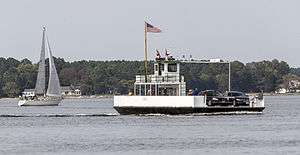Tred Avon River
| Tred Avon River | |
| Third Haven River | |
 The Tred Avon from the Oxford-Bellevue Ferry at Oxford | |
| Name origin: Corruption of "Third Haven" | |
| Country | |
|---|---|
| State | Maryland |
| Region | Eastern Shore |
| Tributaries | |
| - left | Papermill Pond, Jacks Creek, Playtors Creek, Peachblossom Creek, Trippe Creek, Goldsborough Creek, Town Creek |
| - right | Dixon Creek, Shipshead Creek, Maxmore Creek, Plaindealing Creek, Fox Hole Creek |
| Cities | Easton, Oxford |
| Source | Seth Demonstration Forest |
| - elevation | 65 ft (20 m) |
| - coordinates | 38°45′12.4164″N 76°02′03.7824″W / 38.753449000°N 76.034384000°W |
| Mouth | Choptank River |
| - location | Benoni Point |
| - elevation | 0 ft (0 m) |
| - coordinates | 38°40′02.4276″N 76°11′08.8002″W / 38.667341000°N 76.185777833°WCoordinates: 38°40′02.4276″N 76°11′08.8002″W / 38.667341000°N 76.185777833°W |
The Tred Avon River (a corruption of "Third Haven River") is a main tributary of the Choptank River in Talbot County on Maryland's Eastern Shore. The river is 17 miles (27 km) long.[1]
Geography
The Tred Avon's headwaters are located approximately 2.5 miles (4.0 km) southeast of Easton, the county seat. The river flows 5 miles (8 km) roughly west past the city then widens and flows southwest about 12 miles (19 km) to the mouth just south of Oxford at Benoni Point.[2] The mouth is marked by the Choptank River Light, a 35-foot spider in the main channel.[3]
Name
"Tred Avon" is a corruption of "Third Haven."[4] It follows the dropped 'h' characteristic of early Chesapeake sailors from western England. The United States Geological Survey's Geographic Names Information System lists[2] the following variant names for the Tred Avon River:
- Third Haven Creek
- Third Haven River
- Threadhaven Creek
- Trad Avon River
- Tread Haven Creek
- Treavon Creek
- Tred Aven River
- Tred Haven River
- Tredaven Creek
- Tredaven Creeke
- Tredavon Creeke
- Tredhaven Creek
- Trudhaven River
History

With the colonial port of Oxford founded near its mouth between 1666 and 1668, the river served as a major shipping lane in the international tobacco trade until the end of the American Revolutionary War, when wheat became the Eastern Shore's main cash crop and Oxford's monopoly on colonial trade ended, leading to an economic downturn.[5] With the decline in trade came a post-Civil War rise in oyster harvesting, causing a renewed local economic boom lasting until the depletion of oyster beds in the Tred Avon and lower Choptank in the 1920s from overharvesting.[5]
Maryland governor Martin O'Malley sought to revive the river's oyster beds through citizen participation by initiating the "Marylanders Grow Oysters" project in September 2008, which encourages waterfront property owners to grow oysters from their piers using cages; after a 9- to 12-month growing period, the oysters are moved to a protected sanctuary in the Tred Avon.[6]
The Oxford-Bellevue Ferry, believed to be the oldest privately operated ferry service in the United States,[7] offers shuttle service across the river from April to November.
See also
References
- ↑ U.S. Geological Survey. National Hydrography Dataset high-resolution flowline data. The National Map, accessed April 1, 2011
- 1 2 "Tred Avon River". Geographic Names Information System. United States Geological Survey. Retrieved January 6, 2011.
- ↑ P192 Cruising the Chesapeake; A Gunkholer's Gide (Third Edition), William H Shellenberger, McGraw Hill, 2001
- ↑ Wiencek, Henry (1989). "Virginia and the capital region." Smithsonian Guide To Historic America. (New York: Stewart, Tabori & Chang) p. 294. ISBN 1-55670-632-4
- 1 2 "A Landing at Oxford". Retrieved November 8, 2008.
- ↑ "Governor O'Malley Announces New Citizen Oyster-Growing Program, Maryland Oyster Planting Record". Maryland Office of the Governor. September 24, 2008. Retrieved November 8, 2008.
- ↑ "Oxford-Bellevue Ferry". Retrieved November 8, 2008.
External links
- NOAA nautical chart 12266 – Chesapeake Bay: Choptank River and Herring Bay (showing Tred Avon River)
- Marylanders Grow Oysters